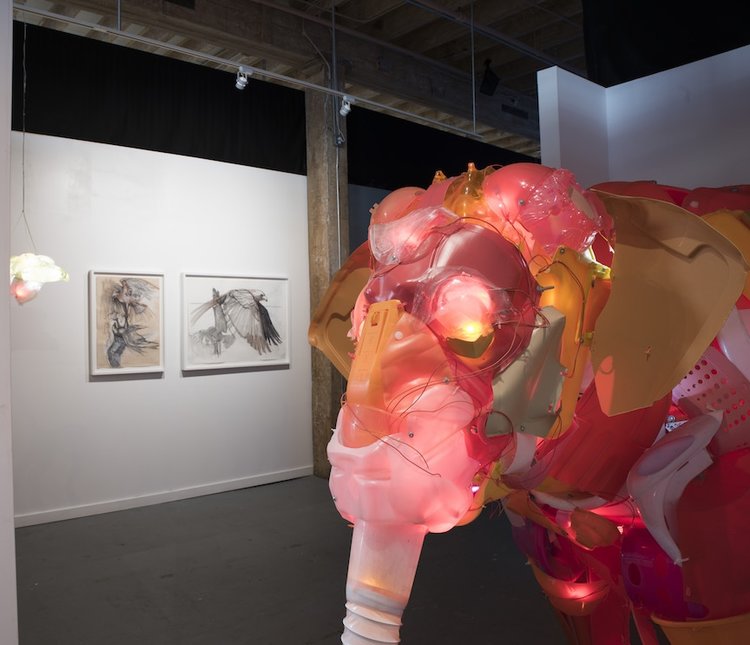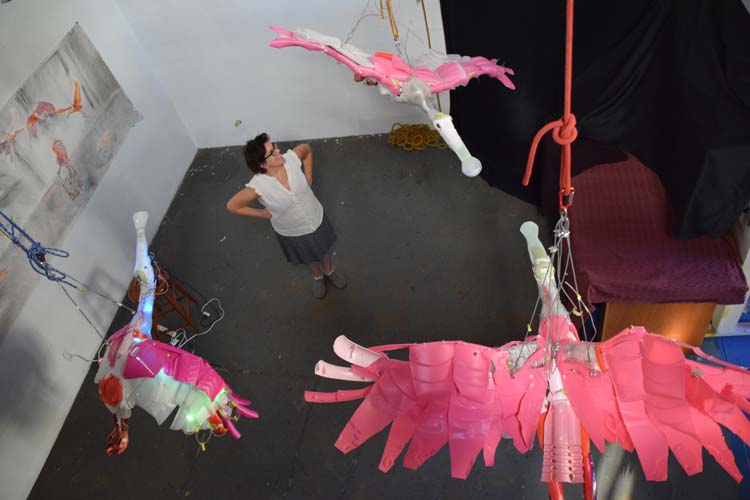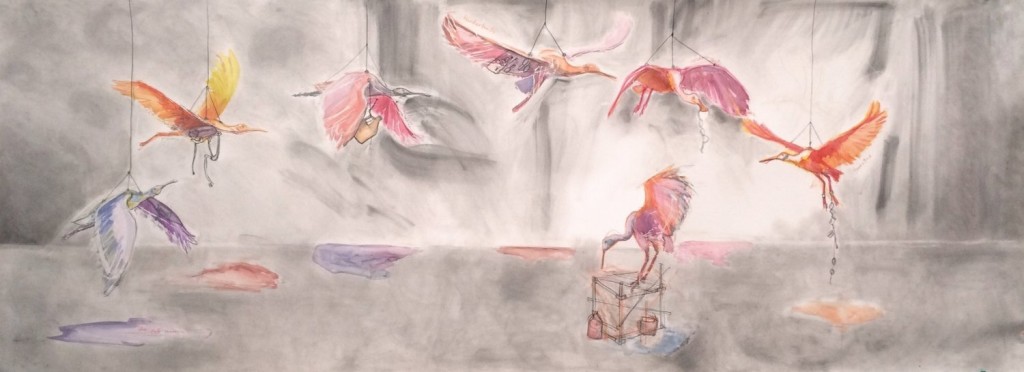Los Angeles based artist and sculptor Cynthia Minet creates dynamic, soul-alive animals. This is found art that’s “found” new life in her vivid, LED-illuminated glowing animals. Whether it’s a life-sized baby elephant, a camel, or an ox, Minet uses post-consumer plastic, PVC, and LED lights to shape her mixed media sculptures. The figures essentially have a transparent plastic skin, through which the LED-lighting wires run like veins. She also draws these animals in a beautifully realistic, motion-filled style. These serve both as models for her sculptures and as a different way to express the life of her animals.
At the same time, Minet exposes the waste of our dependence on plastic, transforming these discarded products into sculptural beauty.
“My process involves drawing, research into anatomy, gesture and behavior of animals, model and armature building, collecting of materials, lots of trial and error, and exploration of different ways of working with light and color,” Minet says.
Minet’s meticulous attention to detail with her large-scale figures results in life-like creatures that are both dreamscape and entirely realistic. They’re moving and intimate, the glow from her LED lights manifesting an almost spiritual presence.
The incredible use of found materials in her work developed fortuitously in 2008, when Minet was invited to create an exhibition in an Italian nightclub. “The club was next door to a recycling facility. I had just seen an amazing show of work using fiber optics and light in Finland. I came back to LA and started working with plastics and light right away.”
Minet says her work is influenced by “Everything having to do with science, anatomy, environmentalism, place, social issues, light and color.” Specific artists also inspire her, including the work of Auguste Rodin and Marcel Duchamp, Louise Bourgeois, and Olafur Elliason, as well as Lee Bul’s work.
Currently, the artist is working on Migrations, a solo project for the International Museum of Art and Science in McAllen, Texas, which will run from November 2017 to February 2018.
She says there are a number of aspects as to the museum’s location itself that excite her: the fact that McAllen borders Mexico on the Rio Grande, and that it lies on the Avian Central Flyway Corridor.
“Both of these factors inspire me to create an installation that features seven life-size sculptures of roseate spoonbills, and one that considers both avian and human migration through the use of found materials and interactivity.”
She describes the show as consistent with her other work focusing on animals and environmental issues, and that it, too, uses LEDs and post-consumer plastics, and is site-responsive. However, the work is also different from past projects. “It’s interactive; motion sensors will activate sound elements, and the lights will incorporate a sequencing animation to enhance the sense of movement in the work. I am collaborating with Vaugh Hannon, an artist and technical wiz, on the interactivity and the lighting sequences,” she explains. “I do seek help with lighting design, as that is a continuous learning curve for me.”
There are other differences in the material that she is utilizing as well.
“It incorporates materials gathered from the borderlands along the Rio Grande River, and carries a political as well as environmental message. When I visited McAllen, I found some materials dropped by migrants along the river, and I remain struck by the pathos in those objects. I left the clothes I found behind because I found them too sad for me to handle, but I collected plastic bottles, toothbrushes, a hat, sandals.”
Additionally, Minet also received items collected by McAllen-based artist and activist Scott Nicol. “He has sent me Homeland Security bags, a small child’s necklace, earphones, and other items. I have imbedded these items into the bird sculptures, so that the works point to the desperation and resilience of the people who are continuously risking all in order to make a better life for themselves.”
Minet relates that she views her role in this new installation as a “provocateur without answers. I hope to encourage a dialogue around the complexity of the social, political and environmental issues in the region, and by extension, on our planet.”
Following her installation in Texas, Minet has plenty to fill her calendar, with her Peace on Earth Migrations installation set for January 2019 at the Museum of Art and History in Lancaster, Calif.
She’s also scheduled to construct a solo installation in the window and lobby area of the Craft and Folk Art Museum in Los Angeles, in September, 2019.
“The CAFAM show will be a new interactive sculptural project that will be influenced by the La Brea Tar Pits and the Page Museum across the street,” she notes.
Minet says what she most wants people to understand about her art is the multiple layers of meaning she puts into it. “I want to capture a sense of life in my work. I build everything myself, as I like the challenge of solving the engineering problems of how things fit together and come apart.”
Let it glow.
- Genie Davis; photos provided by the artist











Yay! Nice job Genie, thanks for taking the time to write about my work!!